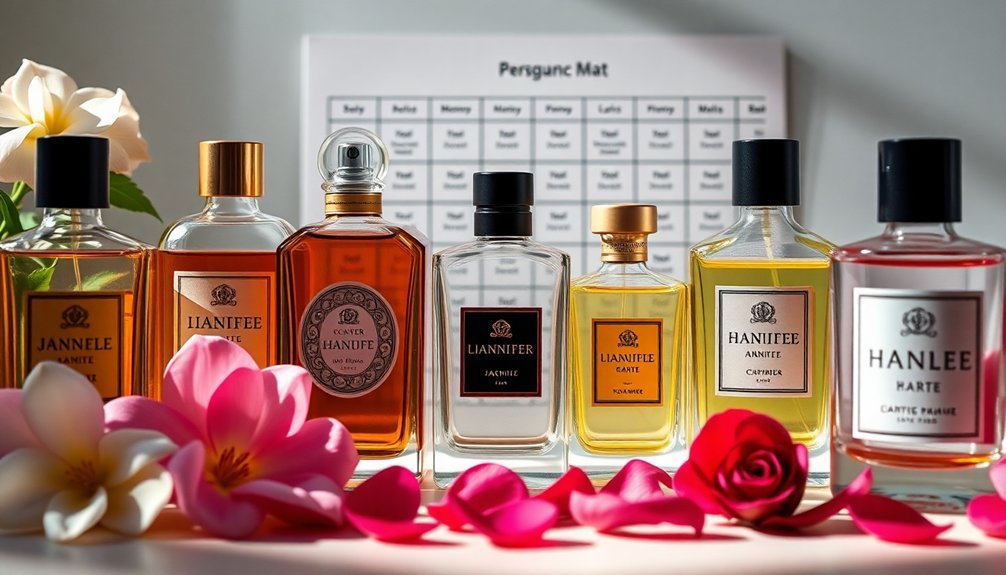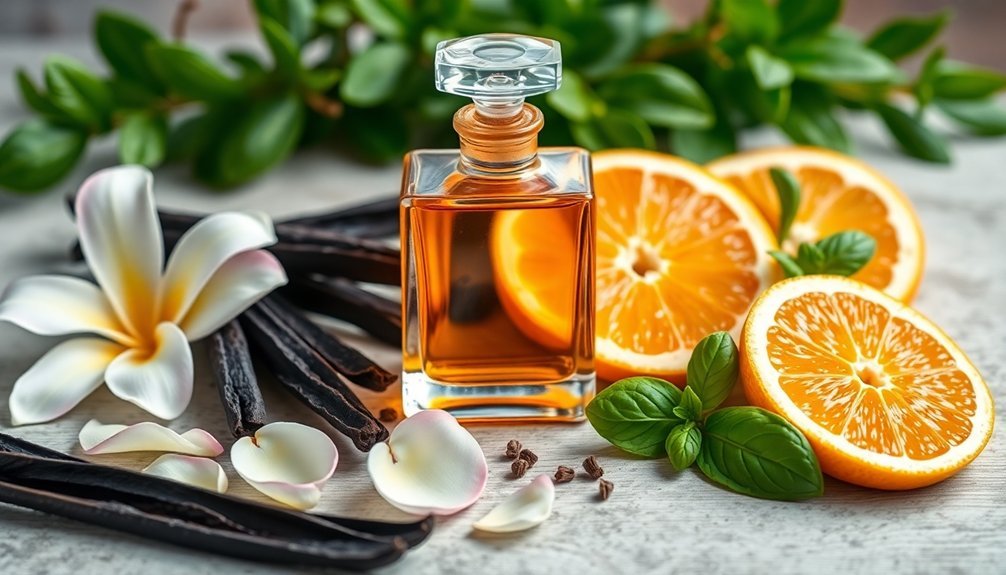To match fragrance notes effectively, start with the fragrance wheel as your guide, pairing adjacent scents for harmony or opposite notes for contrast. You'll want to layer strategically: begin with heavier base notes like vanilla or sandalwood, then add heart notes (typically florals), and finish with light top notes. Test combinations on paper strips first, then on your skin to see how they interact with your body chemistry. A deeper understanding of note classification and layering techniques will elevate your perfume game.
Understanding the Art of Fragrance Note Classification

When you're diving into the world of perfumery, understanding fragrance note classification serves as your foundation for appreciating and creating scents.
Think of perfume as a three-tiered pyramid: top notes capture your attention first, lasting 15-30 minutes with fresh, citrusy, or light floral scents.
Heart notes emerge next, forming the fragrance's core with florals like rose and jasmine, lasting several hours. These heart materials play a vital role as they provide the essential smell of perfume, defining the fragrance's true character.
Base notes anchor the composition with rich scents like vanilla, amber, and spices, providing the longest-lasting impression.
You'll find these notes organized into distinct odor groups: fruity, green, herbal, citrus, dairy, and edible.
The ABC's of Perfumery helps you understand how these notes relate through their physical and chemical structures, making it easier to create balanced, harmonious combinations.
The Science Behind Top, Heart, and Base Notes
When you layer perfume notes, you're working with different evaporation rates that create a harmonious symphony over time, from the quick-dissolving top notes to the long-lasting base notes.
You'll find that balancing the intensity of each note is essential, as stronger base notes can overpower lighter top notes if not properly proportioned.
Your fragrance journey starts with understanding how these notes interact, as some combinations naturally complement each other while others might clash, affecting the overall longevity and character of your perfume. Mid notes like floral ingredients reveal their true scent after 15 minutes and help bridge the gap between top and base notes.
How Notes Evaporate Together
Understanding how perfume notes evaporate together reveals the intricate science behind a fragrance's evolution on your skin.
When you apply perfume, the top notes create an immediate impact but fade within 15 minutes, featuring volatile oils like citrus and fruit scents. As these dissipate, heart notes emerge after 3-4 hours, delivering the fragrance's core character through florals and spices.
Base notes, the most enduring elements, become noticeable after 5-8 hours and act as fixatives to enhance the overall longevity. Diluting with alcohol helps separate distinct notes that would otherwise blend together like a chaotic orchestra.
Your skin's temperature and oiliness can accelerate or slow this evaporation process. For best results, don't rub the perfume, as this can disrupt the natural evaporation sequence.
Store your fragrances in dark, room-temperature conditions to maintain their intended evaporation pattern and protect their molecular structure.
Creating Lasting Scent Balance
The art and science of perfume balance stems from a sophisticated interplay between three distinct note categories. When you're selecting fragrances, understanding how these notes work together can help you achieve longer-lasting scent experiences.
| Note Type | Characteristics |
|---|---|
| Top | Light, volatile, immediate impact |
| Heart | Complex, balanced, core scent |
| Base | Deep, rich, long-lasting |
| Layering | Enhanced longevity through note repetition |
| Balance | Ideal proportion between components |
To create lasting balance, you'll want to reflect on how each note evaporates and interacts with your skin chemistry. While top notes provide that initial burst of fragrance, heart notes maintain the scent's character, and base notes guarantee longevity. Your skin's unique chemistry will influence how these notes develop, making each perfume experience distinctly personal.
Note Intensity Matters
Diving into the science of fragrance notes reveals a fascinating hierarchy of molecular structures that determines how each scent unfolds over time.
You'll notice top notes immediately – these volatile compounds, like citrus and mint, create your first impression but evaporate quickly within minutes to hours.
Your fragrance's heart notes emerge within ten minutes, offering complex floral, fruity, or spicy elements that can last up to three hours.
These mid notes are essential as they give your perfume its distinctive character while balancing the composition.
The base notes are your fragrance's foundation, appearing after 30 minutes and lingering for hours or days.
You'll find these less volatile molecules, such as vanilla, woods, and musks, provide the lasting depth that makes your scent memorable and uniquely yours through interaction with your skin chemistry.
Essential Combinations for Perfect Perfume Harmony
You'll find that floral-oriental combinations, like jasmine with vanilla or rose with amber, create enchanting depth and warmth in your fragrance.
Natural woody notes, such as sandalwood and cedar, pair beautifully with both floral and oriental bases to add richness and staying power.
These classic combinations work because they follow the principles of complementary notes while maintaining balance between the intensity levels of each scent.
Floral-Oriental Perfect Matches
When expertly paired, floral and oriental fragrances create some of perfumery's most enchanting combinations.
You'll find that sweet floral notes like rose and jasmine beautifully complement the warmth of vanilla, musk, and exotic spices. To achieve this harmony, start with a familiar floral base, then layer oriental notes on top.
For the perfect balance, you'll want to match scents of similar intensity. Consider adding a complementary middle note, like woody or fruity elements, to bridge the two families.
You can look to celebrated examples like Tom Ford Black Orchid or YSL Opium for inspiration. These combinations work especially well for evening wear and formal occasions, particularly during colder months when their warmth and sensuality can truly shine.
Natural Woody Note Pairings
Moving from the allure of floral-oriental blends, woody notes offer an entirely new dimension in perfume pairing artistry.
You'll discover four main combinations that create enchanting fragrances: woody-citrus, woody-floral, woody-oriental, and woody-woody pairings.
When you pair woody notes with citrus, you'll get an invigorating blend that balances heaviness with revitalizing zest.
Combining woods with florals creates sophisticated depth, perfect for both elegant and casual occasions.
If you're seeking mystery, try woody-oriental combinations, where amber and spices merge with woods for long-lasting allure.
For pure earthiness, experiment with different woody notes together – think sandalwood with cedarwood or vetiver – to achieve rich, smoky complexity.
Each pairing offers unique characteristics while maintaining the grounding nature that makes woody notes so versatile in perfumery.
Creating Your Personal Scent Pairing Matrix

The art of creating a personal scent pairing matrix combines science and intuition to craft your signature fragrance combinations.
Start by exploring the fragrance wheel to understand how different scent families interact. You'll discover which notes naturally complement each other and which create intriguing contrasts.
Begin experimenting with sample blotters, then move to skin testing to account for your unique chemistry. Apply lighter scents first, followed by stronger ones at your pulse points.
As you test different combinations, note which pairings resonate with your style and personality.
Don't hesitate to blend neighboring families on the wheel, like florals with woody notes, or create bold statements with opposite pairings.
Your matrix will evolve as you discover new combinations, helping you build a distinctive fragrance wardrobe that's uniquely yours.
Master Techniques for Layering Different Notes
Building on your personalized scent matrix, mastering the art of layering takes your fragrance game to new heights.
Start by selecting a medium-intensity base fragrance with balanced notes and good longevity that complements your body chemistry. Choose scents with vanilla, sandalwood, or patchouli as stable foundation notes.
Apply your fragrances strategically on pulse points, starting with the heaviest concentration first. Let each layer settle before adding the next. You can either apply fragrances directly on top of each other or blend them by spraying on separate areas and gently mixing them together.
Don't forget to take into account seasonal adjustments – opt for lighter combinations in summer and warmer blends in winter. Remember to start with small amounts and build up gradually until you achieve your desired intensity.
Building Complex Fragrances With Simple Components

Creating complex fragrances doesn't require an extensive collection of ingredients, as mastering a few versatile components can open countless possibilities.
You'll find that understanding how basic notes interact allows you to craft sophisticated scents with minimal elements. By focusing on complementary combinations and proper proportions, you can develop unique fragrance profiles that evolve beautifully over time.
- Start with three core components: one each from top, heart, and base notes – like bergamot, jasmine, and vanilla.
- Experiment with different ratios to discover how concentration affects the final scent.
- Layer synthetic ingredients with natural ones to achieve better longevity and stability.
- Test your blends on paper strips first, then skin, to understand how they develop throughout the day.
Remember that even professional perfumers often begin with simple combinations before building more intricate compositions.
The Fragrance Wheel: Your Guide to Note Compatibility
Mastering fragrance combinations becomes intuitive when you understand the Fragrance Wheel, a revolutionary tool developed by Michael Edwards to simplify scent pairing. The wheel organizes scents into four main families: Floral, Oriental (Amber), Woody, and Fresh, with each containing distinct subfamilies.
You'll find three reliable techniques for creating harmonious blends. The Neighbor technique pairs adjacent fragrances, like florals with fresh notes. The Opposite method matches scents from across the wheel, such as soft oriental with citrus, creating intriguing contrasts. The Triangle approach combines three subfamilies in a triangular pattern for balanced complexity.
To start experimenting, identify your preferred fragrance family, then explore complementary notes using these techniques.
Don't forget to test combinations on your skin, as personal chemistry affects the final result.
Frequently Asked Questions
How Long Should I Wait Between Applying Different Layered Fragrances?
You'll want to wait 3-5 minutes between each fragrance layer. Let each scent settle and blend with your skin before applying the next one. This guarantees proper mixing without overwhelming your senses.
Can Weather Conditions Affect How Fragrance Combinations Perform?
Yes, weather heavily impacts your layered fragrances. Hot temperatures amplify top notes but reduce longevity, while humidity can enhance or dull combinations. You'll want to adjust your layering strategy based on seasonal conditions.
Should I Layer Fragrances Directly on Skin or Clothes?
You'll get the best results by combining both methods – apply fragrance to your pulse points for personal scent evolution, and lightly mist clothes for longevity. This dual approach creates a balanced, long-lasting fragrance experience.
Do Expensive and Affordable Perfumes Layer Well Together?
Yes, you can layer expensive and affordable perfumes successfully if they share complementary notes. It's not about the price tag – it's about how well the fragrances' dominant notes work together to create your desired scent.
How Can I Remove Layered Fragrances if I Don't Like the Combination?
You can easily remove layered fragrances with simple methods like washing with soap and water, using an oil cleanse, or applying a baking soda paste. For stronger combinations, try a detox bath or witch hazel.
In Summary
You're now equipped to create your own signature scent combinations by understanding how fragrance notes interact and complement each other. Whether you're layering different perfumes or selecting a single complex fragrance, you'll recognize which notes work together harmoniously. Trust your instincts, experiment with the fragrance wheel as your guide, and don't be afraid to break traditional rules to discover your perfect scent story.
References
- https://www.fragrancex.com/blog/fragrance-wheel/
- https://www.fragrancex.com/blog/layering-perfume/
- https://www.fragrancex.com/blog/fragrance-notes/
- https://www.maison21g.com/articles/how-to-mix-perfumes-creating-the-perfect-fragrance-combination
- https://herbandroot.com/blogs/self-love/fragrance-layering-tips-for-the-novice
- https://www.perfumersworld.com/abcs-perfumery.php
- https://www.pairfum.com/identifying-key-notes-perfume/
- https://www.craftovator.co.uk/blogs/academy/top-middle-bottom-notes-understanding-the-fragrance-pyramid-and-scent-notes
- https://thefragrancebook.com/blogs/perfumes/how-perfumes-classified
- https://experimentalperfumeclub.com/what-are-top-middle-and-base-notes-in-perfume/





Leave a Reply